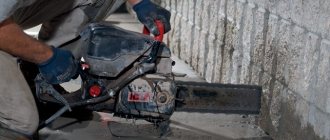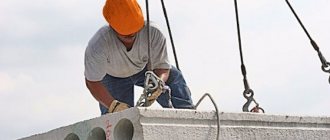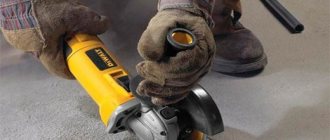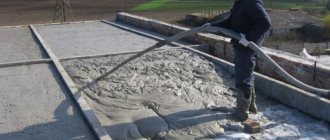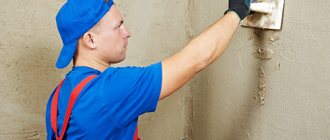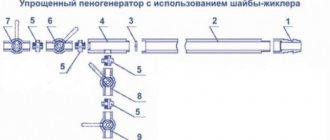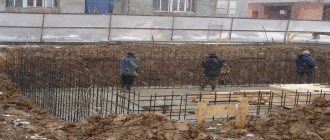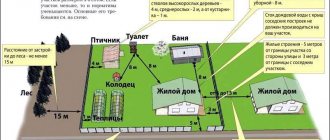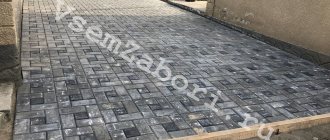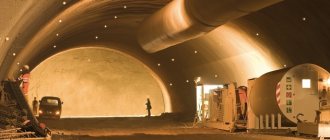Concrete saw - purpose of the tool
Saws used in the construction industry allow cutting blocks of cellular types of concrete on a construction site. The question may quite reasonably arise: why is it necessary to cut ready-made blocks that have standard sizes?
Saws are divided into several types. It’s not about aerated concrete, but about the scale of the work, complexity and desired result
There are several possible reasons:
- preparation of products of non-standard dimensions. The use of additional elements is associated with the characteristics of the masonry;
- ensuring the correct geometry of the building material. Laying blocks with smooth edges requires less mortar;
- production of blocks of radius configuration. When constructing buildings, there is a need to create an opening of complex shape;
- use of defective products. After sawing off the chipped area, you can use the remaining part of the block building material.
To summarize, cutting blocks of cellular concrete is necessary to solve a wide range of problems. An ordinary saw will not be able to cope with the task, because cellular concrete is quite durable. The use of special saws equipped with a hardened working body with Pobedit tips allows processing at different angles.
Drying foam concrete blocks
In conditions of continuous production, when there is no time to wait for many hours or even days for the polymerization of blocks, an additional technological stage is used - thermal drying. For this purpose, a special chamber is used into which foam blocks are loaded. Construction technologies for making bricks necessarily include the use of kilns as a means of firing and strengthening. Foam concrete is a less dense material, so thermal effects are often dispensed with - but to save time and strengthen the structure, this stage will not be superfluous. According to experts, oven steaming in a couple of hours allows the block to gain about 70% of the basic strength. Organizationally, this technology for producing foam blocks is only possible on automated lines. The machine must automatically control the loading and unloading processes associated with the movement of cassette molds into the oven.
Reciprocating saw
Demonstration of a reciprocating saw when cutting foam blocks.
The electric saw makes cuts with flat blades that look similar to the blade of a saber, which is why it got its name. The amplitude of movement of the canvas can be different, it all depends on the model. They vary from 3 to 5 cm. An electric hacksaw easily copes with gas and foam concrete blocks and makes cuts quite quickly. Using the saber model is easy. The operating principle is similar to that of a chain saw.
Models may vary:
- frequency of movements per minute (2.5-3 thousand);
- range of motion (1.9-2 cm);
- Block cutting depth.
Using a reciprocating electric saw, you can quickly and efficiently cut aerated concrete blocks. The speed in many models is controlled by an electronic unit. Cooling occurs through the existing ventilation holes. The vibration level is adjusted and low. The reciprocating saw weighs about 4 kg. Replacing the blades is quite simple.
Which cutting tool should you prefer?
How to cut foam concrete?
What cutting tool is better for processing foam concrete than cutting it in order to minimize the cost of maintaining the device?
To answer these questions, you need to decide on the following parameters of the construction project:
- The total volume of processed foam blocks.
- Dimensions of foam concrete blocks.
- Electrification of a construction site.
- Project budget.
- Professional skills of builders.
Wall chaser for foam concrete
Low-rise private construction
Hand saw for foam concrete
When building a private one-story house of medium size, for example, in a country house, as a rule, no more than 10-12 cubic meters of foam concrete are used. If there are no time constraints on the project and the budget is unlimited, a reciprocating saw is an ideal option.
Reciprocating saw for foam concrete
However, if there is no power source on site or the ability to use a cordless saw model, as well as a limited budget, a hand saw will do.
This could be, for example, a saw for foam concrete Bison. Its resource is quite enough to complete the construction of a house with the help of one or two builders.
Saw for foam concrete Bison
Tool for a multi-story house
Two-story house made of foam blocks
How to cut foam concrete blocks when building a two-three-story cottage, house or non-residential premises? To construct such a structure, it will be necessary to perform a large number of cutting operations, and under different conditions.
For basic work you will need an automated device. The best option would be a band saw; to fine-tune the geometric features, you can use a small reciprocating saw or hacksaw.
Reciprocating saw for foam concrete
High-rise buildings, workshops and production premises
High-rise building made of foam blocks
When constructing high-rise residential buildings, foam concrete blocks are used either as cladding on a reinforced concrete frame, or as a base, but with reinforcement inside the wall. In both cases, you have to cut a large number of foam concrete blocks. In this case, the dimensions of the blocks used may be limiting.
Foam concrete cutting machine
Naturally, cutting foam concrete with your own hands in the main scope of work in this case is ineffective. Here we need automated cutting plants and complexes for foam concrete. These can be band saws, machines for cutting foam concrete, and reciprocating saws and hacksaws for foam concrete used in some special cases.
Do-it-yourself foam concrete cutting
Tape
The electric band saw is a professional tool powered by a closed band made of high-strength metal. The advantage of the device is that it supports height adjustment and optimal performance. Using a cutting blade, you can make a high-quality longitudinal or shaped cut.
Chain models are used to organize U-shaped blocks from simple structures
To extend the service life of equipment and maintain it in working condition, it is important to carry out deep cleaning of working parts from lubricants and oils in a timely manner. Otherwise, dust will begin to accumulate on the sticky consistency, which will lead to rapid wear of the working parts.
Tape
The devices are designed for cutting various materials using a closed belt made of metals using high-frequency alloys. The band saw for aerated concrete has the advantage of height adjustment and good performance. Cutting of aerated concrete blocks is carried out using a tape; this technique allows you to make longitudinal and shaped cuts.
Chainsaws are used to create U-blocks from standard products. According to reviews from builders, it is recommended to clean chain saws from oils and lubricant mixtures. Because they cause dust from aerated concrete to stick to the mechanism, which provokes accelerated wear of the moving elements.
A frequently asked question is: is it possible to cut aerated concrete with a chainsaw? According to reviews from craftsmen, a strong abrasive occurs during work, and the tool quickly becomes dirty and fails. Therefore, it is better to use an electric saw for aerated concrete, where a filter is put on the side of the brushes.
What types of cutting tools are there?
In order to be able to cut the required size from an aerated concrete block, several methods can be used.
Hand tool
Manual is used very often, it is convenient when you have a small amount of work. It can be used directly at the construction site. Usually it is needed to cut off the block when constructing corners.
The main advantage of a reciprocating saw is the high accuracy of both reciprocating and straight cuts.
If you look at the design of such a saw, it is similar to the one used for working with wood, but this is not entirely true. This tool has a thicker blade, which allows you to work with hard materials without deforming the saw blade.
To get a high-quality cut, you also need to use a metal corner, a ruler and a pencil. A modern saw for aerated concrete is made of high-carbon steel. The teeth can be made of a cermet alloy, which allows them to withstand high loads. Rapid blades also have good performance.
Usually, when purchasing a hacksaw for aerated concrete, it includes spare blades.
When choosing a hand saw, you need to pay attention to indicators such as the length and thickness of the blade, as well as whether soldering is done on each tooth or every other one. If you only need to cut a few blocks, then you don’t need to buy a power tool; you can do this work with a hand saw
If you only need to cut a few blocks, then you don’t need to buy a power tool; you can do this work with a hand saw.
To operate a power tool, you must have an electrical outlet, and this is not always possible. Another argument in favor of a hand saw is that its cost is at least 10 times less than that of an electric one.
Reciprocating saw
Another type of tool is a reciprocating saw. It operates from the mains and is a hand tool. The blade is driven by a motor; it moves forward along a line and backwards in a rotational-translational manner. In appearance, it is similar to a regular electric drill, only it is equipped not with a drill, but with a cutting blade.
Reciprocating saws are distinguished by the following characteristics:
The electric saw is not only effective in use, but also quite easy to care for.
- blade length;
- engine power.
It is convenient to use when during work you need to adjust a large number of blocks, from 300 or more pieces. Before starting work, you need to outline the line and only then make the cut. A modern high-quality reciprocating saw usually includes additional accessories, such as a metal corner, replaceable handles and blades.
Band-saw
A band saw can be used. It has higher performance than previous options. The blades of such tools are made of hard alloys, and it is possible to adjust the height of the working surface.
Electric saw
This unit is universal; it can be equipped with different blades, which are used for rough and precise cutting. Such saws have fairly high performance and at the same time low cost, so they are often used in construction.
Block cutting equipment
Professional production of foam blocks is not complete without special cutting lines that work with monolithic concrete. In terms of cutting tools, this is a very diverse equipment - band cutters, strings, circular saws, metal cables, etc. can be used. Such equipment for foam blocks is based on a platform or frame, which is also designed to accommodate the target material. As they work, the cutters walk along the monolith, leaving behind stripes of separated segments. A cross pass completes the cutting operation, leaving finished blocks.
This method has several advantages over casting. First of all, the accuracy of the formation of edges and sides is ensured. Thanks to this, the quality of future installation also increases. In addition, if molding in some cases requires the application of a special lubricant to the edges of metal cells, due to which the adhesion of block surfaces suffers, then cutting preserves the roughness of the edges and thereby improves their adhesion to other foreign surfaces. In addition, there remains complete freedom in regulating the parameters with which foam blocks are produced. The dimensions and weight of products may vary: they are made in the standard format 200x300x600 with an average weight of 500 kg per 1 m2, and with individual characteristics.
What are the options?
Electric saw
The tool can be used for a long time because it is powered from the mains.
Thanks to the power supply, the tool has high productivity and allows long-term sawing of gas blocks. The disadvantage is limited coverage due to the dependence on the length of the device cord and the presence of an electrical outlet. Cordless hacksaws are more autonomous, they can be transported to any part of the construction site, but they are inferior to the first option in power.
Hand saw
Unlike wood tools, concrete processing equipment has a thicker working belt. There are one- and two-handed options. This type of saw is used when you need to quickly process a concrete block, but the amount of work is small. Widely used on construction sites for cutting aerated concrete directly during laying. The set may include a square that helps maintain a right angle when cutting.
Tape
Such a device should be chosen when there is a need to process material in a large volume.
Designed for processing a large number of gas blocks. It is characterized by soldering on the teeth. Outperforms manual models by 20 times. Using a band saw, smooth cuts are made for further laying on glue. It is possible to saw several concrete blocks at the same time. You can adjust the height of the working surface.
Saber
Externally, a hacksaw for foam concrete resembles a jigsaw. The saw is equipped with two cutting blades and one fixed blade for fixing at the cutting site. The cutting occurs through rotational and translational movements of the blade. On the return stroke it rises above the concrete. The advantage of this type of hacksaw is direct cutting with high precision, which cannot be achieved with other types of saws.
The tool cuts out the required material as accurately as possible.
Casting manufacturing technology
At the first stage, the solution itself is prepared, which can be done in a regular construction bin with an automatic mixing function. Next, the created mixture is poured into cassette molds, where the mass of foam concrete takes on the specified physical parameters. Traditional injection molding technologies provide for the possibility of further vibration and compaction in the molds, which will improve the quality of the block. However, in simplified cassette forms this function is absent due to the lack of an electric drive that could provide a vibration effect.
More modern matrices with formwork allow you to change the configuration of the cells. That is, the user can adjust the thickness and length of the block in accordance with his needs. This also makes it possible to create foam blocks with individual parameters in single copies - for example, for masonry in difficult places. The period of polymerization, that is, hardening, varies on average from 10 to 20 hours. This largely depends on what kind of adhesive was used for the foam blocks - waterproof, silicone or polymer based. After basic strengthening of the structure, the blocks can be freed from the formwork walls.
Classification of hacksaws
Hacksaws are divided into several types: for wood, metal, aerated concrete (foam concrete) and drywall. This division is due to the fact that saws, which have different teeth, as well as the shape of the tool, are intended for different jobs. For example, a hacksaw can cut not only wood, but also aerated concrete and drywall. A metal cutting tool cuts metal, but is also capable of sawing all other materials.
On wood
When buying a hacksaw for wood, you need to be careful. They differ from each other in the shape of saws, handles, types of teeth
A hacksaw for wood can be:
- classical;
- narrow;
- thorny.
A classic hacksaw is also called a regular or wide hacksaw. This saw cuts wooden things lengthwise or crosswise. The saw teeth are triangular, the pitch between them is from 1.5 to 6.5 mm. The classic type quickly cuts wooden products, the only drawback is that the carving itself is rough and a lot of shavings remain, but it is perfect for garden work.
Narrow (circular) is a specialized saw. A hacksaw can have teeth on both sides, which provides a more accurate cut. This tool is designed for carving when you need to carefully cut out parts from wood.
The tenon blade is designed for accurate cutting, when the cut is beautiful and there are not so many chips left. The hacksaw teeth have the shape of an isosceles triangle. The saw is used only for transverse threads; the width of the tool is usually no more than 1-1.5 mm.
Types of wood hacksaws are also divided depending on the shape of the teeth:
- longitudinal;
- transverse;
- universal.
However, such a tool is not suitable for cutting laminate. After the 20th cut, it will be very difficult to work, since the teeth will already be very dull.
For metal
This is a type of saw that is designed for cutting metal structures. Such a tool can cut wood, aerated concrete, and drywall, but is not capable of cutting stone and concrete.
It is better, of course, to use a hacksaw for its intended purpose and cut only metal structures. The saw includes the following elements: a hacksaw blade, a frame for fastening and a handle for holding the saw.
The tool blade can be single-sided or double-sided. The convenience of a double-sided blade is manifested in the fact that the saw blade for metal wears out quickly, it is necessary to constantly update it, and when there are two sides, this can be done less often.
When inserting the blade into the mounting frame, it is important to do it correctly, otherwise the cutting speed will decrease, and thus the saw may break. For professional metal saws, you can also adjust the angle of inclination and make it 45, 90 or 180 degrees
For professional metal saws, you can also adjust the angle of inclination and make it 45, 90 or 180 degrees.
For aerated concrete and foam concrete
To cut aerated concrete or foam concrete, you will need to buy specialized tools. Such saws have a specific design with pobedit tips. The teeth of the tool make a more rigid cut into the surface of the material.
A hacksaw for aerated concrete is used for both longitudinal and transverse cuts. Hacksaws for foam concrete are represented by three types of cutters:
- 2-2.5 mm – used for small parts and neat carvings;
- 3-3.5 mm – used for medium sizes;
- 4-6 mm – the product is large and difficult to cut.
For drywall
A drywall hacksaw or circular saw is used to cut this material and also cut out various holes. This saw is made of high-quality steel, so it is almost impossible to break it.
The blade of the drywall saw is thin, the length of the blade does not exceed 20 cm, the tool has a comfortable compact handle, so this saw can be used to cut out various parts and do it carefully.
Characteristics of foam block
The performance characteristics are already reflected in the foam block marking itself. For example, to focus on thermal insulation, you should choose brands from D150 to D400. Due to its high density (the numerical value indicates the ratio kg/m3), this material provides sufficient insulation for houses located in mid-latitudes. In terms of strength, this is not the most advantageous option compared to traditional brick, for example. On average, the strength limit is 9 kg per 1 cm3. Another thing is that even the production of foam blocks at home allows the introduction of plasticizers and fillers that can increase certain properties, including strength and frost resistance.
In factory conditions, technical qualities are also improved due to the base composition. Brands D500-D900 are considered structural and thermal insulating, that is, suitable both for providing heat in northern regions and for maintaining reliability in terms of physical activity. By the way, the strongest blocks can withstand up to 90 kg per 1 m2 - this is the D1200 brand. Standard sizes may vary, but there is a standardized format for producing material that is considered optimal. This is a foam block 200x300x600 mm, which, depending on the composition, provides a wall density from 300 to 1200 kg/m3. At the same time, water absorption is stable at 14%.
How to saw with different tools
We already know how to cut foam blocks. It remains to understand how to do this.
The manual method is considered the most common, but it does not always give good results, it is tiring and time-consuming. In addition, it is recommended to follow certain rules:
- do not press on the saw, otherwise the blade will deviate to the side;
- Before sawing blocks, you need to make sure that the material is dry. Wet crumbs will get stuck in the cuts, complicating the work;
- to obtain an even cut, mark the block on three sides and make small cuts of 2–3 cm;
- the saw is held at an angle of forty-five degrees. The block must lie completely on the working surface so as not to break off ahead of time;
- The hacksaw blade should completely cover the block along its entire length.
Now let's look at how to cut foam blocks with an electric tool:
- Experts advise practicing all movements with the tool turned off before starting work. The cutting is carried out not as a full blade, but as a central zone, the size of which should be about 25 cm;
- cuts should be made from 2 sides, moving towards each point.
Circular and chain tools imply certain actions:
the element on each side is marked with shallow cuts. If you have a large blade, many people try to cut the material in one go.
Many people are interested in whether it is possible to cut foam blocks with a chainsaw. If the situation requires processing a small amount of material, then such a saw can be used. But immediately be prepared for the fact that the cut will be uneven, and there will be enough dust.
Mini-factories for creating foam blocks
In small industries, for optimization purposes, small production lines are often used, in which functional areas are compactly concentrated. The concept of a mini-factory for foam blocks is based on the same principles. The operator does not need to artificially fill gaps between technological stages - production is controlled by automation from start to finish. The line begins with a hopper in which the mixture for foam concrete is mixed. The operator adds all the necessary components with additives and sets a program for preparing the building mixture. Next, the solution is fed into a container, which will form a rectangular monolith.
A typical mini-plant for the production of foam blocks works using the block cutting method, since it is initially focused on obtaining elements with precise geometric dimensions. After natural or oven hardening, the monolith is sent to the automatic cutting stage, from where it is transported in the form of finished blocks to the receiving point.
Band-saw
The tool is a multi-cutter cutting machine. The cutting is carried out with a circular steel strip, on one side having teeth. Band saw performance is high. Thus, using a machine, you can cut foam concrete 20 times faster compared to a manual hacksaw.
Band saw for cutting foam blocks
A high-tech alloy of hard metals is used for the guide blade. The machine is indispensable in the construction of large objects. With a band saw you can cut blocks of any width, as the height is adjustable. The big advantage is that this saw does an excellent job with foam and aerated concrete of any type, regardless of whether it is autoclaved or natural.
There are models that cut straight and diagonally. The machine can be equipped with an automated self-tensioning function, which affects the cutting accuracy of concrete blocks. Guide rollers allow you to increase the working life of the band saw, and the gaps in the cutting blade, with the help of which waste is removed, ensure non-stop operation.
The band saw is equipped with eyes and wheels, which makes it possible to transport it. Additional stops in the machine contribute to stability during operation. There is also a dust extraction system, which immediately absorbs all the dust when the machine is operating.
Choosing the right saw for foam concrete
Only with the right approach can you buy a hacksaw for good quality aerated concrete and foam concrete
Reviews from owners of such instruments show that you need to pay attention to the following criteria when purchasing:
- Thickness of the tool blade - you can purchase equipment with a blade 0.2 mm thick, but you will have to work hard with it, especially if you work without a square. However, such devices allow you to obtain a finishing cut. Thick blades do not bend during the sawing process and allow you to quickly achieve your goals, but they make the cut rough
- Length - the larger the size, the better, but not always. If you plan to lay foam blocks measuring 200-300 mm, then a hacksaw with a blade 500-600 mm long will be quite sufficient. If you want to choose the right tool length, then the size of the material to be cut needs to be multiplied by two
- Materials from which the blades are made - the performance and efficiency of the device depends on the quality of the steel used in production
- The shape or design of the handle - they are made of plastic, which is covered on top with a rubberized base or silicone. The handle affects the convenience of performing work, which is especially important for large volumes
- Weight plays an important role, since the lighter the equipment, the more difficult it is to saw with it. The craftsman needs to apply additional force to press the device onto the material being cut. Heavy files with pobedite tips require only reciprocating movements from the master
- Manufacturers - the instruments in question are produced by different companies, not only in Russia, but also in Europe, as well as China. It is not relevant to overpay for German quality, since reviews show that models from manufacturers Zubr, Matrix, Sturm, Bacho and others have proven themselves well.
- Price is the main indicator of quality. When buying a cheap hacksaw for aerated concrete, you need to understand that it will not last long. Cheap devices are also called disposable, since they are usually enough for one-time work. A budget saw costs about 600-700 rubles, and a good quality hacksaw with soldered teeth from pobedit will cost several thousand rubles
From the material it is clear what advantages and disadvantages a hand tool for processing foam concrete has. Now we can draw a conclusion about the rationality of using the device in question, as well as the features of its choice.
https://youtube.com/watch?v=LStE4KBLFvs%3F
Publications on the topic
Hand hacksaw, its purpose, types and how to choose
How to use a foam gun - device, types, selection and repair
Pipe clamp - a hand-held tool for cutting threads on steel pipes
What types of files are there - their purpose, application and selection
Application area
Some builders use an ordinary standard wood hacksaw to cut foam concrete, claiming that it does the job no worse than a special saw for this material. However, if an ordinary hacksaw cuts aerated concrete, this does not mean that its use is effective.
A hacksaw for foam concrete does not have this property, since its teeth are covered with carbide pobedit tips. This allows not only to extend the service life of the tool, but also to facilitate the process of sawing material. The instrument in question is used for the following purposes:
- In order to refine the forms, thereby obtaining foam blocks of the required size.
- For the production of additional prefabricated blocks in an assembly fit, since at least one block in a row always needs to be trimmed.
Varieties
The tool for sawing aerated concrete (foam block) can be different and have some differences:
- By type of drive, tools are manual, electric and gasoline. Manual ones are the cheapest, but their use requires physical strength.
- Depending on the type of blade production, the tools are saber, belt and disk. Hand saws involve the use of reciprocating blades.
Hand hacksaws also differ from each other in the following parameters:
- Canvas length. An important parameter, since the blade is longer than the size of the block itself, allowing it to be cut not only in the transverse, but also in the longitudinal direction. The lengths of the files are 50 – 70 cm.
- Thickness of steel sheets. The thicker the canvas, the better. This parameter affects the quality of work and also eliminates possible distortions of the tool. For the manufacture of blades, hardened or stainless steel is used. Some manufacturers coat their products with a special protective layer, thereby extending the life of the product.
- The presence of soldering on the teeth. For foam concrete sheets, alloys such as pobedit, rapid, and monocarbide are used, through which the material is effectively sawed. Such alloys increase the service life of the tool and also make it easier to work with. Soldering on the teeth can be applied either through one or on each one.
Electric and gasoline saws are intended primarily for use in construction, when the volume of work is quite large, and it will be physically difficult to do the sawing yourself with a hand hacksaw.
Features of choice
If you are choosing a hacksaw for foam concrete, it is important to pay attention to some parameters and characteristics of the purchased product. To select such a tool, it is important to pay attention to the following parameters:
Thickness of the canvas. This parameter also affects the possibility of “finishing” or “roughing” processing of the material. The thickness of the products ranges from 0.2 mm to 1.5 mm. Length of the product
When choosing, it is important to know what size the material to be cut will be. The length of the material should be multiplied by two, and then, based on the result obtained, select a hacksaw
If you don’t know how long the foam block will be, then it’s better to choose something in between 50 cm. Material. If you plan to perform large volumes of work, then you should purchase products made of hardened steel. Cheaper options are made from stainless steel. Handle shape. Take the tool in your hand and try it for yourself. The file should lie securely and confidently in your hand. Any imperfections in the grip of the handle will be presented in the form of calluses and chafing, and will also be reflected in the form of rapid fatigue. Manufacturers. Today, the number of manufacturers of such tools is quite large, which is due to the popularity of the building material. When choosing, it is important to pay attention to popular models that have positive reviews. You should not check the quality of Chinese or little-known models, the cost of which is several times lower than the average price for a tool. The most popular models of hacksaws for foam concrete include: Intertool, Bacho, Mirax, Enkor, Zubr, Sturm. Product price. The cost of products starts from 600 rubles, but it all depends on the manufacturer and the technical parameters of the product.
In conclusion, it should be concluded that if you approach the choice of the tool in question with all the desire, then the purchased tool will definitely delight you for more than a dozen working seasons.
Hacksaw for aerated concrete: concrete, foam concrete, gas block with Pobedit tips
› Concrete Production › Working with Concrete › Processing
28.11.2019
Aerated concrete hacksaw is a special tool designed for sawing and cutting lightweight cellular concrete, thanks to which you can simplify the task and increase efficiency. Due to the high popularity of aerated concrete in private and industrial construction, the choice and purchase of a hacksaw becomes relevant for everyone who works with the material.
Aerated concrete is a lightweight type of concrete with pores inside. It is light, durable, but fragile. Therefore, a regular hacksaw is not suitable for cutting - the tool will quickly wear out due to the high abrasiveness of aerated concrete, and the block itself may crumble or become cracked. Using a special hacksaw makes it possible to cut blocks into pieces of any size and configuration simply, quickly and efficiently.
Typically, a hacksaw for concrete of this type is used in cases where it is necessary to make additional aerated concrete blocks, adjust the existing material to the required size, create a non-standard shape, etc. Before purchasing a tool for cutting aerated concrete, you need to familiarize yourself with the main characteristics and selection criteria.
Where is it used?
Quite often, to cut aerated concrete, inexperienced craftsmen take an ordinary hacksaw for wood, which usually ends in damage to the tool and poor quality of the cut. A regular hacksaw is not designed to work specifically with porous aerated concrete, and you need to choose the right tool.
So, sawing with a hand hacksaw will take on average 5 times more time and effort than using a special saw for a gas block. The main distinguishing feature of the tool is the presence of special pobedit (carbide) soldering on all teeth. The pobedite element has increased strength and is used for a reason.
What problems are solved by pobedite soldering on hacksaw teeth:
- Significant extension of the service life of the tool - thanks to strong soldering, the teeth do not wear out or wear out during the cutting process, so you can cut many blocks without worrying about the rapid failure of the saw.
- Facilitating and increasing the efficiency of the sawing procedure - teeth with pobedit tips cope with the material easier and faster (albeit with the appearance of a large amount of dust, and therefore it is necessary to work in a respirator).
- Significant savings due to the absence of the need to spend money on expensive gasoline and electric tools for cutting aerated concrete.
What is a hand saw for aerated concrete blocks used for:
- Dividing one block in half to produce smaller elements.
- Cutting off excess in isolated cases (when creating additional elements).
- Refinement of the existing form of aerated block (when some unusual structures are created).
The design of a hacksaw for aerated concrete is very simple: the working part is a blade with teeth located on one side, and the handle is made in the form of a handle, which the master holds during the implementation of the work. The saw is completely reminiscent of the design of a wood hacksaw, with the only difference being that the teeth are usually made of a different shape and design.
How is it different from a hacksaw for wood?
In appearance, the saw, which can quickly and easily cut foam concrete, is not much different from a hacksaw for wood. There are two main differences.
The main differences between a hacksaw for aerated concrete and a saw for wood:
- The length of the blade is 50-70 centimeters - the element is elongated, making it possible to use the tool for sawing an aerated concrete block not only across, but also lengthwise.
- Greater thickness of steel - concrete (even light) is more durable than wood, therefore the working element is made of a more reliable and durable material. Typically, the thickness of a hacksaw blade for aerated concrete is up to 1.5 millimeters.
- The teeth are arranged in one row and made larger. It is also important that the teeth must be soldered with carbide (usually Pobedit) materials.
True, there are hacksaws for gas blocks that do not require soldering from pobedit. Usually these are budget models, where the teeth are simply heat treated. Such devices demonstrate a small resource, therefore they are suitable for performing a small amount of work (on average, they are enough for a maximum of 20-30 cubic meters of blocks).
All high-quality models of hacksaws for aerated concrete are necessarily made with pobedite soldering, which can be applied to each tooth or every other tooth.
About the types of hacksaws for cutting foam concrete
Before choosing a tool suitable for performing the tasks, you need to study all existing types and the most common options.
Classification criteria for hacksaws for aerated concrete:
- Drive type - the saw can be manual, gasoline, or electric. Hand saws are similar to hacksaws for wood, electric/chainsaws require a standard design with the need to install disks/saw chain with pobedite soldering before starting work.
- Blade type - hand and reciprocating tools, as well as disk and automatic units.
If the craftsman already has an electric/gasoline saw, to work with a gas block it is enough to purchase a special chain with pobedit soldered on all teeth. But such a chain will cost 2-3 times more than a similar consumable for wood. Therefore, many people prefer to buy a hand saw for not too large-scale work.
Types of hand saws and their characteristics:
- The length of the canvas varies in the range of 50-70 centimeters. The longer the blade, the more possibilities: it will be possible to cut an aerated concrete block across/lengthwise.
- Blade material - usually good hacksaws are made from stainless and alloy steels, which demonstrate high strength and allow you to cut even shell rock.
- The thickness of the canvas - the thicker the better, but the cost also increases similarly. Thick blades do not deform or bend during operation, therefore they give a straighter and more even cut, without distortions. To obtain an even cut, craftsmen also recommend using a square or corner template.
- Soldering on the teeth is a very important point, on which the service life of the tool and, in many respects, the quality of cutting depend. In addition to pobedit, monocarbide, rapid, etc. are also used for soldering.
Where is it used?
There is an opinion that it is quite possible to work with aerated concrete and saw it using a carpenter’s saw available in any household. However, it is incorrect. Despite the lightness of the cellular material, it has sufficient strength. Another of its characteristics is abrasiveness, that is, a pronounced ability to grind and abrade surfaces. It’s easy to imagine how quickly an unsuitable device that just happens to be at hand will become unusable. Accordingly, the use of special hacksaws is recommended for working with such blocks.
They are used for:
- refining the shape, obtaining cellular “bricks” of the required size;
- manufacturing of additional prefabricated blocks for installation (usually at least one block in a row is trimmed during construction).
Stripping technology
This method is essentially reminiscent of injection molding, but with a greater degree of automation. Classic molding can be done entirely by hand using homemade metal cells. Automatic formwork requires operator participation only in the process of regulating the pouring into the original forms. Next, the machine independently picks up the forms onto a pallet and holds them in its hopper (sometimes with heat) until they completely harden. It is difficult to organize such production of foam blocks at home, since the equipment may require connection to a 380 V network, but if there is a three-phase line, it is quite possible. Moreover, the mixture is also prepared in a third-party way without connecting special units. After hardening, the installation automatically opens the hopper, takes out the form with blocks on a pallet and removes the formwork.
Electric reciprocating saw
Saws of this type are hand-held electric tools, the blades of which perform rotational-translational movements in a horizontal plane. When moving back, the tool blade rises slightly, which makes sawing blocks easier. Externally, a reciprocating saw resembles a jigsaw. Models of this type are equipped with blades with teeth of different sizes and shapes, and can also be battery operated.
The main advantage of this tool is the ease of cutting (both straight and saber). At the same time, the cutting accuracy is several times higher than that of a hand saw.
With the help of reciprocating saws, you can not only cut blocks of the required size, but also make neat grooves for cable networks.
The cost of tools and blades for reciprocating saws depends on the set of additional tools, the power of the units and the manufacturer.
Casting equipment
Three categories of equipment will allow you to implement the injection molding method. First of all, these are installations for creating foam concrete mixtures. They differ from conventional bunkers in that they have a device for generating foam. The average productivity of such a unit is 20-30 m3 per day, again, it depends on the specific composition. At the next stage, mobile equipment for foam blocks can be used, which will facilitate the task of transporting the mixture to the forms. These can be self-propelled machines with hoppers, or direct stationary channels for supplying the solution specifically to the matrix.
Regarding the forms themselves, it has already been noted that they are matrix cassette cells into which the mixture is poured. At home, an analogue of such a device can be made from ordinary metal sheets. A kind of lathing is constructed, and it does not necessarily have a bottom - during the work process, even factory-made structures are often placed on a flat surface, and this is enough to obtain a geometrically correct masonry material. Another thing is that the technology for manufacturing foam blocks using the injection molding method also provides for the possibility of easy and quick dismantling of the mold after the solution has hardened.
